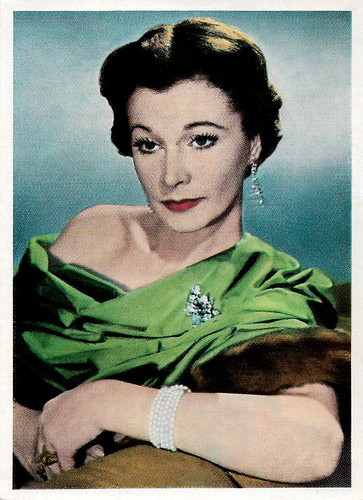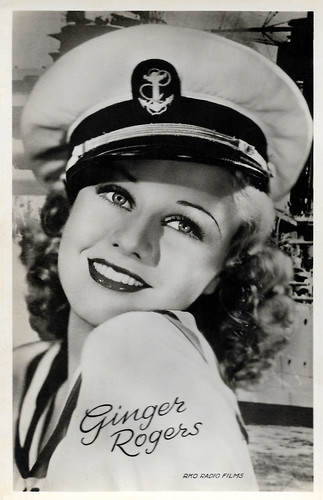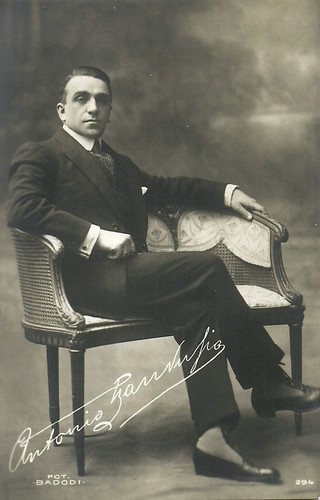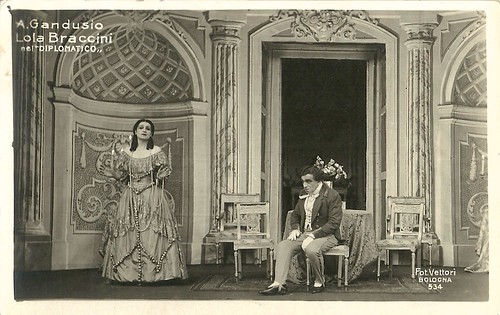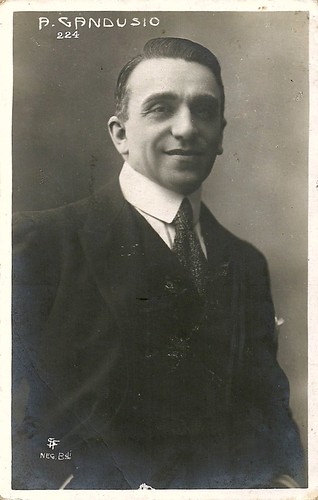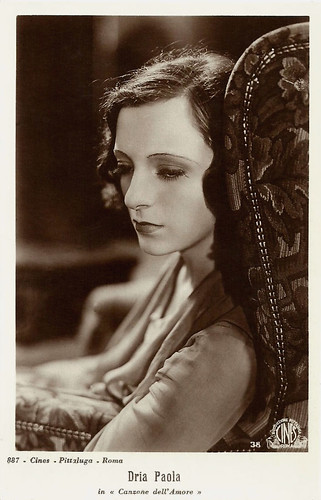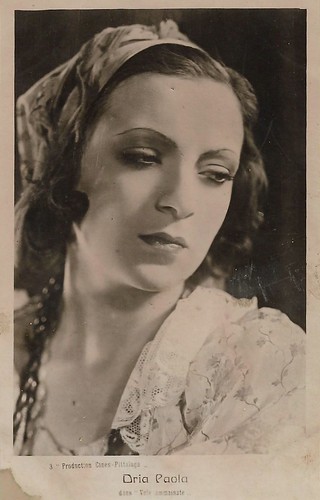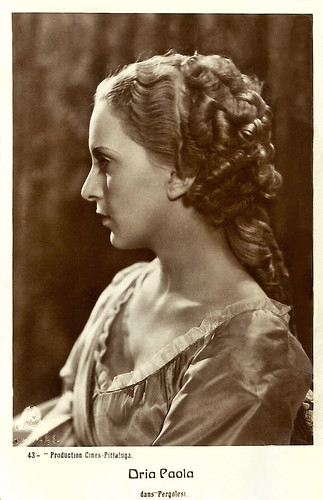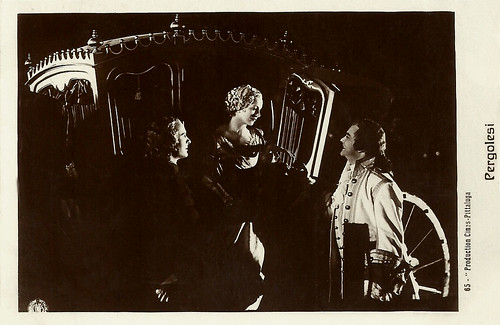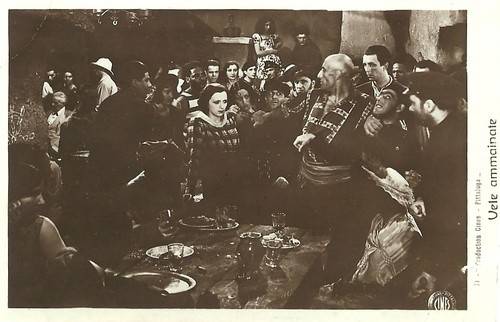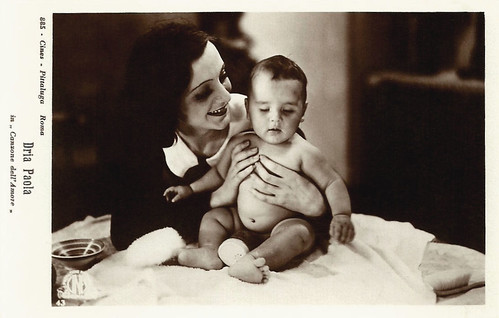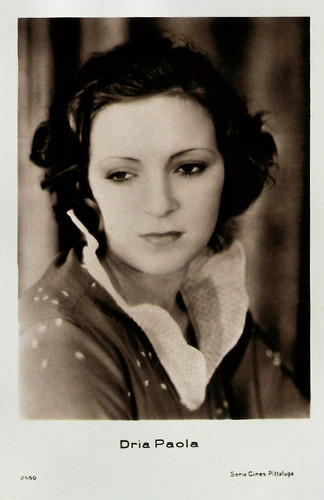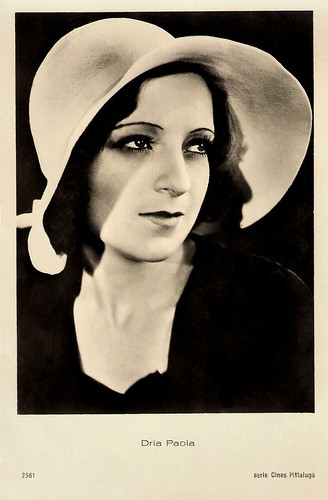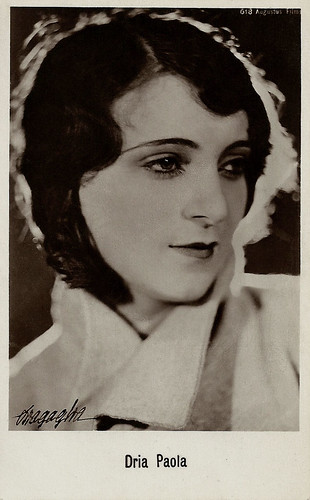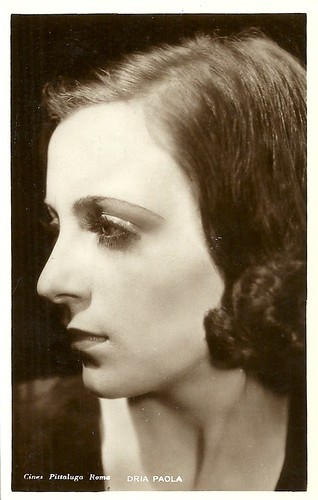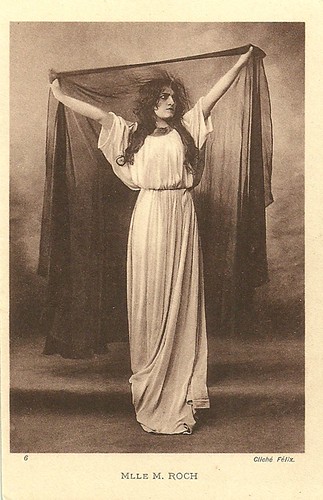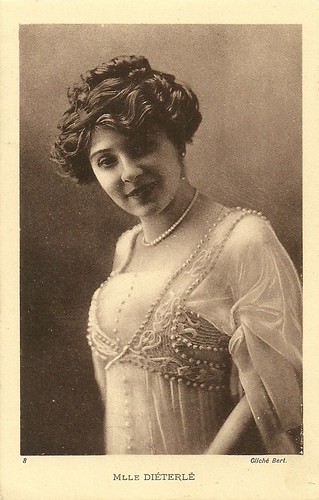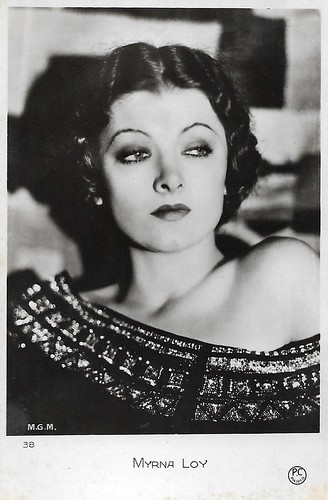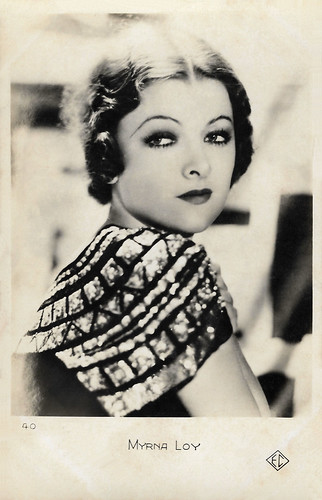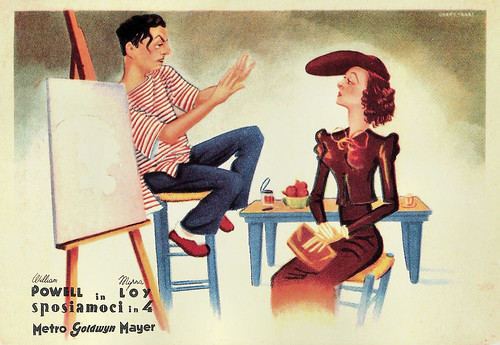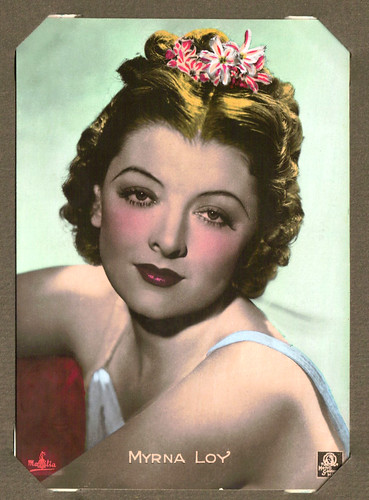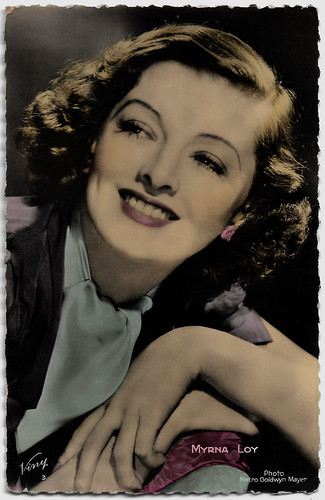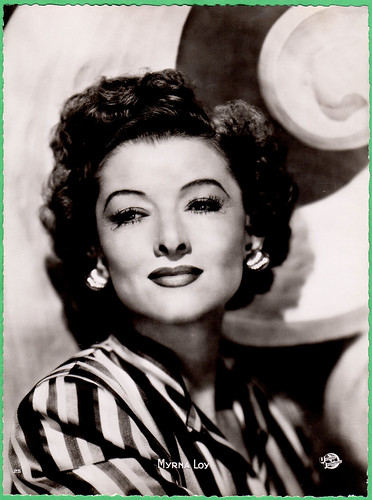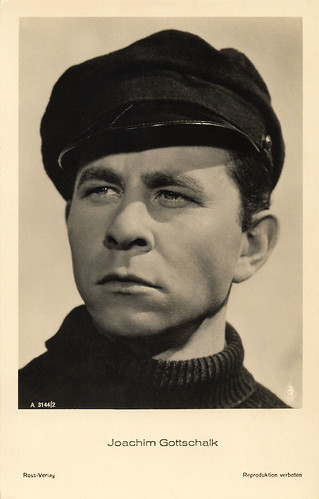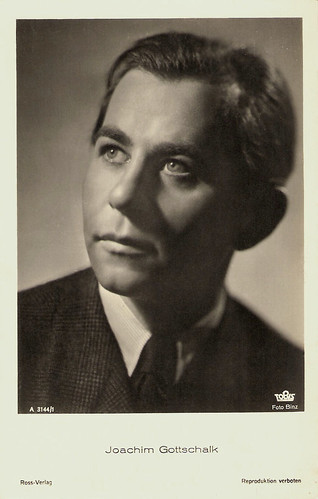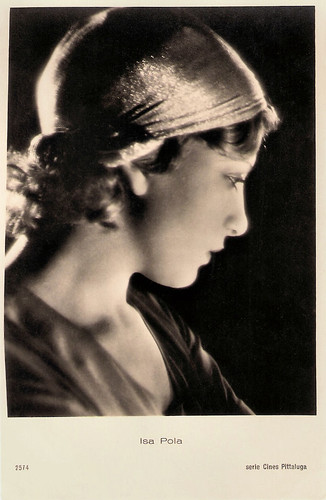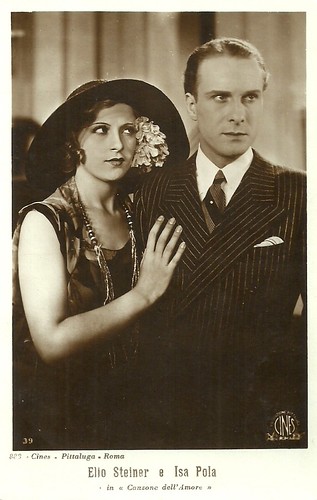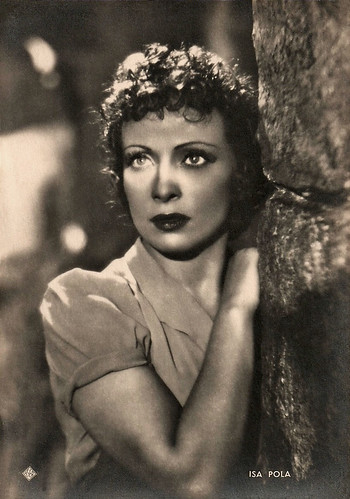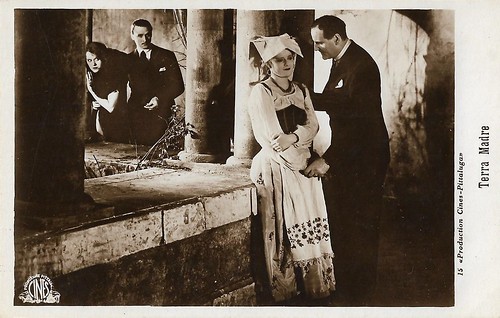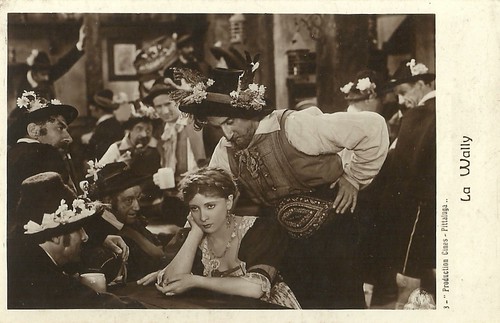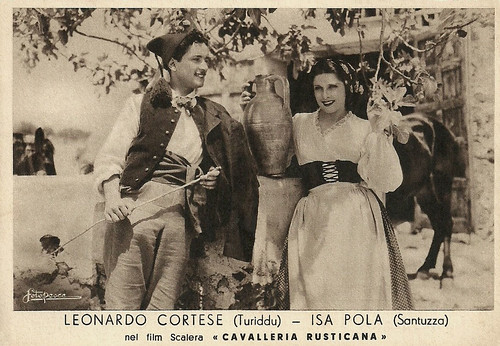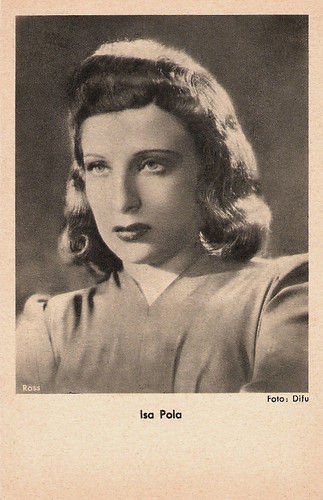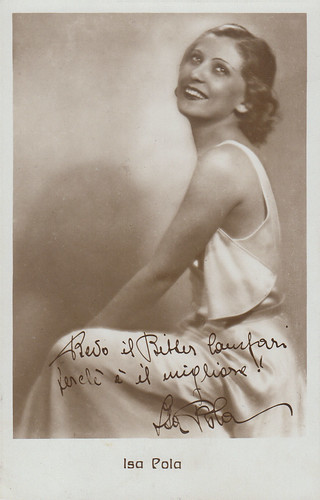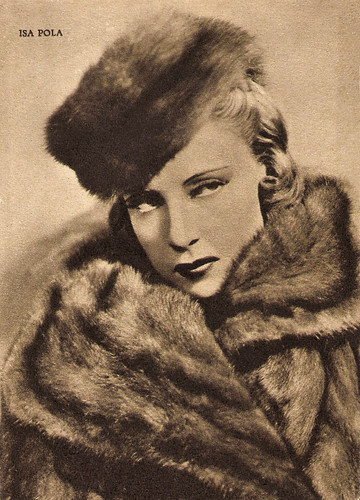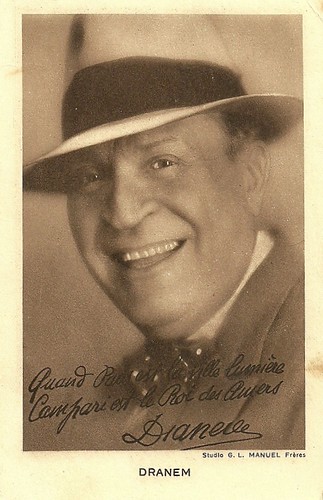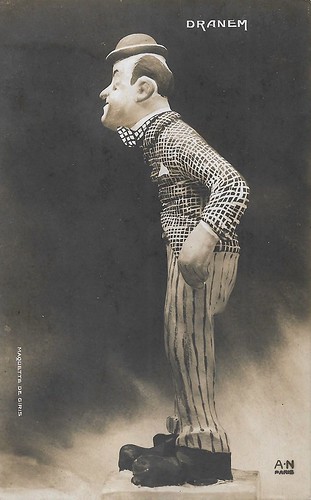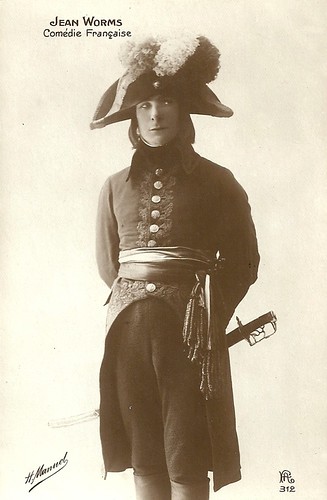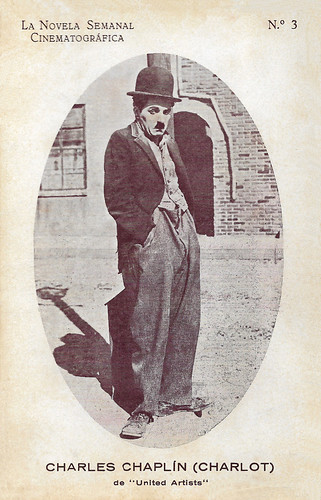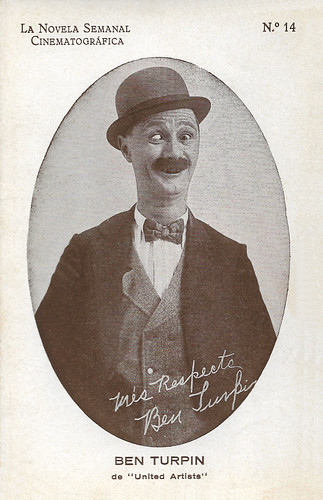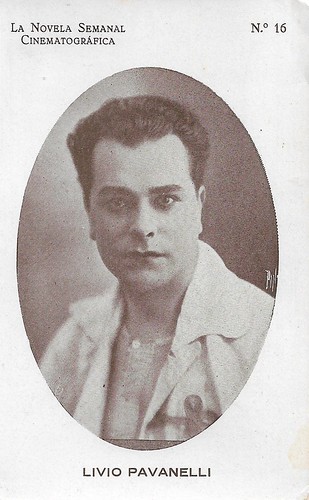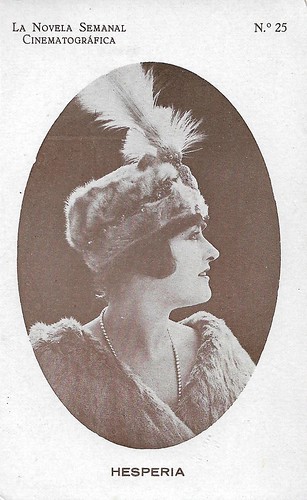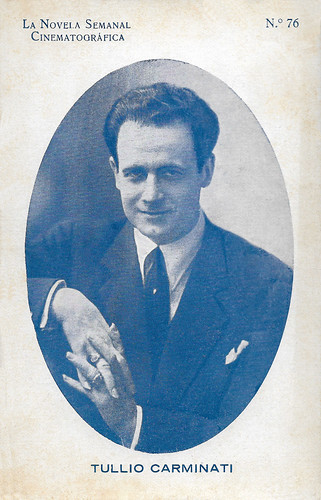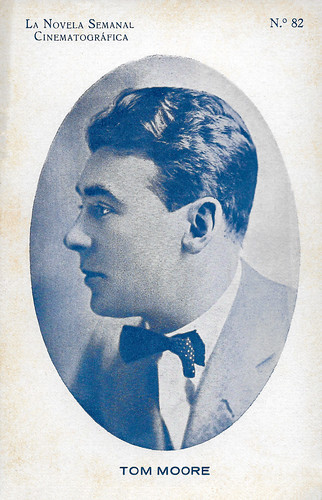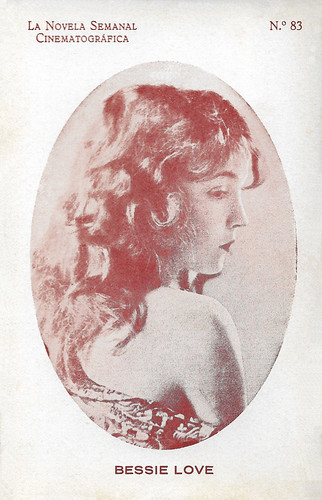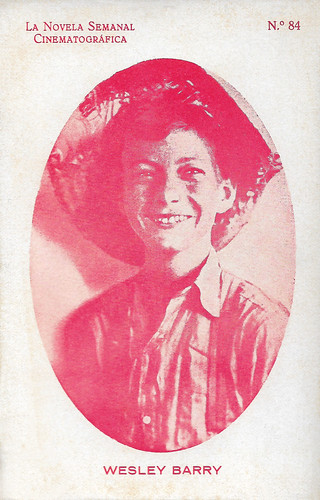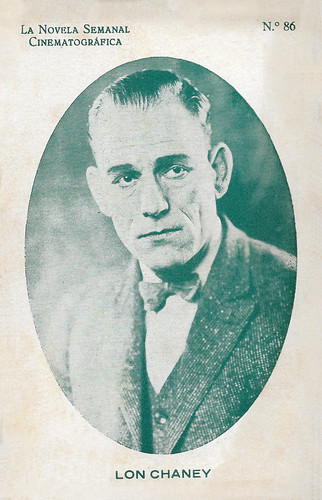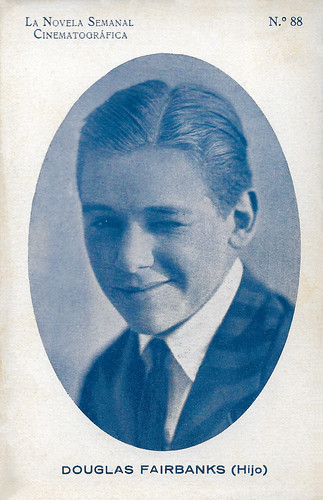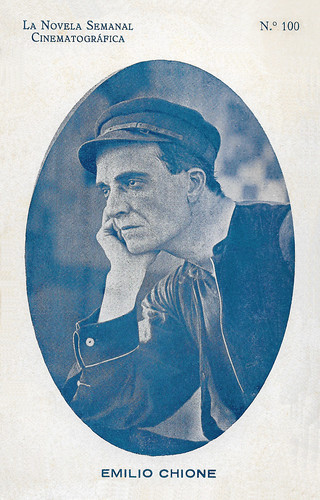Lya Mara (1893-1969) was one of the biggest stars of the German silent cinema. Some immensely successful silent operettas presented her the perfect Viennese Girl. Hundreds of postcards and trading cards cemented her stardom, which was even the subject of a novel, published in 100 episodes between 1927 and 1928. Her career virtually ended after the arrival of sound film. Recently, Marlene Pilaete discovered new facts about this forgotten diva.
![Lya Mara]()
German postcard by Ross Verlag, no. 241, 1919-1924. Photo: Becker & Maass.
![Lya Mara]()
German postcard by Ross Verlag, no. 1455/3, 1927-1928. Photo: Atelier Balázs, Berlin.
![Lya Mara in Die lachende Grille (1926)]()
German postcard by Ross Verlag, no. 1889/3, 1927-1928. Photo: Atelier Schneider, Berlin / Zelnik-Film.
![Lya Mara]()
German postcard by Ross Verlag, no. 3599/1, 1928-1929. Photo: Atelier Balázs, Berlin.
![Lya Mara]()
German postcard by Ross Verlag, no. 3831/1, 1928-1929. Photo: Atelier Balázs, Berlin.
Lya Mara was born as Aleksandra Gudowiczóna in a Polish family in Riga, Russian Empire (now Latvia) in 1893 or 1897. She was the daughter of a civil servant and went to a Catholic boarding school.
As a young girl, she wanted to become a chemist, like Marie Curie, the then famous French woman scientist who was also Polish-born, but instead, Lya went to the ballet school of Riga. One year later, she was already a solo dancer and in the following years, she danced for the Riga State theatre and became astonishingly famous. This success was crowned with her promotion to prima ballerina in 1913.
Just before World War I, Lya moved with her family to Warsaw. Credited as Mia Mara, she played her first small part in the short silent comedy Wsciekly rywal/The Rival (Aleksander Hertz, 1916), and soon thereafter she played another part in Bestia/The Polish Dancer (Aleksander Hertz, 1917). Star of this film was another Polish actress, Pola Negri, who would make an extraordinary career in Germany and Hollywood. Negri left for Berlin, and soon Lya Mara would follow her steps.
Newspaper articles and pictures of Mara had appeared in Berlin newspapers, and she was spotted by the young and energetic actor-director-producer Friedrich Zelnik (later credited as Frederic Zelnik). He summoned her to Berlin. After some screen tests, she signed a contract that obligated her for a total of seven pictures with Zelnik.
Among their first films were Das Geschlecht der Schelme/The sex of the Scoundrel (Alfred Halm, 1917) opposite Zelnik himself, Halkas Gelöbnis/Halka's Vow (Alfred Halm, 1918) opposite Hans Albers, Die Rose von Dschiandur/The Rose of Dschiandur (Alfred Halm, 1918) again opposite Zelnik, and Die Serenyi (Alfred Halm, 1918) opposite Conrad Veidt.
![Lya Mara in Das Geschlecht der Schelme (1917)]()
German postcard by Verl. Hermann Leiser, Berlin, no. 5073. Photo: Berliner Film-Manufaktur. Lya Mara and Friedrich Zelnik in Das Geschlecht der Schelme/The sex of the scroundel (H. Fredall a.k.a. Alfred Halm, 1917). Alfred Halm directed this film and the following films under his regular pseudonym H. Fredall, while he also scripted the film.
![Lya Mara and Friedrich Zelnik in Die Rose von Dschiandur (1918)]()
German postcard by Verlag Hermann Leiser, Berlin-Wilm, no. 3216. Photo: Rudolph Schlesinger. Photo: Berliner Film-Manufaktur. Friedrich Zelnik and Lya Mara in Die Rose von Dschiandur/The Rose of Dschiandur (Alfred Halm, 1918).
![Lya Mara in Die Serenyi (1918)]()
German postcard by Photochemie, Berlin, no. K. 2268. Photo: Berliner Film-Manufaktur. Lya Mara and Victor Janson in Die Serenyi (Alfred Halm, 1918). This is one of two cards Photchemie issued on this film.
![Lya Mara in Halkas Gelöbnis (1917)]()
German postcard by Photochemie, Berlin, no. K. 2271/2. Photo: Berliner Film-Manufaktur. Lya Mara in Halkas Gelöbnis/Halka's Vow (Alfred Halm, 1918).
![Lya Mara in Halkas Gelöbnis (1917)]()
German postcard by Photochemie, Berlin, no. K. 2273. Photo: Berliner Film-Manufaktur. Lya Mara in Halkas Gelöbnis/Halka's Vow (H. Fredall a.k.a. Alfred Halm, 1918). This is one of a set of three cards that Photochemie issued on the film.
![Lya Mara in Die Nonne und der Harlekin (1918)]()
German postcard by Photochemie, Berlin, no. K. 2281. Photo: Berliner Film-Manufaktur. Lya Mara in Die Nonne und der Harlekin/The Nun and the Harlequin (Alfred Halm, 1918). This one of three cards Photochemie issued on the film.
Friedrich Zelnik and Lya Mara married in 1918. Zelnik promoted her to a major star in Germany. Among the following films, he directed and produced with her were Manon (1919), Charlotte Corday (1919), and Anna Karenina (1919) with Johannes Riemann.
From 1920 on, Zelnik's film production company was named Zelnik-Mara-Film GmbH. Lya starred in lightweight fare like Die Ehe der Fürstin Demidoff/The Marriage of Princess Demidoff (1921), and Das Mädel vom Picadilly/The Girl from Picadilly (1921), in which she either played noble ladies or naïve girls from the countryside.
From 1924 on, she only made two Zelnik films a year, among them immensely successful operettas like Die Försterchristel/The Bohemian Dancer (1926), An der schönen blauen Donau/The Beautiful Blue Danube (1926), and Das tanzende Wien/Dancing Vienna (1927), often with Harry Liedtke or Alfred Abel as her screen partner.
Lya Mara perfectly embodied the Viennese Girl, and she enjoyed great popularity all over Europe. Her stardom also was the subject of a novel, 'Lya. Der Herzensroman einer Kinokönigin' (Lya, The Heart Novel of a Cinema Queen), which was published in 100 episodes between 1927 and 1928.
Lya Mara and her husband became real celebrities and received at their home many known artists. Her popularity was further cemented by hundreds of her photographs issued as postcards, chocolate and cigarettes trade cards.
![Lya Mara in Auf Befehl der Pompadour (1924)]()
German postcard by Ross Verlag, no. 914/4, 1925-1926. Photo: Phoebus Film / Zelnik-Mara Film. Lya Mara in Auf Befehl der Pompadour/By Order of Pompadour (Friedrich Zelnik, 1924).
![Lya Mara, An der schöne blauen Donau]()
German postcard by Ross Verlag, no. 56/3, 1925-1926. Photo: Zelnik Film. Publicity still for An der schönen blauen Donau/The Beautiful Blue Danube (Friedrich Zelnik, 1926).
![Alfred Abel and Lya Mara in Das tanzende Wien (1927)]()
German postcard by Ross Verlag, no. 82/2. Photo: Defu. Alfred Abel and Lya Mara in Das tanzende Wien/Dancing Vienna (Friedrich Zelnik, 1927).
![Lya Mara]()
German postcard by Ross Verlag, no. 1608/6, 1927-1928. Photo: Zelnick-Film. Lya Mara in Die lachende Grille/The Merry Madcap (Friedrich Zelnik, 1926)
![Lya Mara]()
German postcard by Ross Verlag, no. 3413/3, 1928-1929. Photo: Defina / DEFU.
![Fred Louis Lerch and Lya Mara in Heut tanzt Mariett (1928)]()
German postcard by Ross Verlag, no. 3414/1, 1928-1929. Photo: Defina / DEFU. Fred Louis Lerch and Lya Mara in Heut tanzt Mariett/Today dances Mariett (Friedrich Zelnik, 1928). Collection: Geoffrey Donaldson Institute.
A serious car accident at the end of the 1920s interrupted Lya Mara's career. There was an immensely huge sympathy from the audience, but somehow she could not adapt her acting to the sound cinema, introduced in Germany in 1929.
While Friedrich Zelnik became the first director in Germany who post-synchronised foreign films, Lya Mara's only film from the sound era is Jeder fragt nach Erika/Everyone Asks for Erika (Friedrich Zelnik, 1931).
In 1932, just before Adolf Hitler took over the power in Germany, Lya Mara and Friedrich Zelnik went into exile in London. There is no record of her acting there, although her husband continued to direct and produce films in England and The Netherlands until 1939.
Friedrich Zelnik died in London in 1950, and since then all traces of his wife were lost for a long time. Lya Mara probably spent her last years with her sister in Switzerland and most sources indicate that she died there in 1960 at the age of 62.
However, 'Ms. Sherlock'Marlene Pilaete discovered the correct facts: "Some passionate historians have found mention of her death in local newspapers. How lucky we are to have such people making research. For example, the Nouvelle Revue de Lausanne mentions on the 6th of November 1969 in its obituary page "Alexandra Zelnik-Gudowicz, 76 years old". At the time, nobody knew that she had been a famous movie star. Please note that, if she was 76 years old when she passed away, it seems that she was born in 1893 and not 1897. Maybe another case of 'rejuvenation'… It wouldn’t be the first time… especially regarding actresses."
So, Lya Mara settled down in Lausanne, Switzerland in 1966. She passed away in that city on 1 November 1969 and she was buried in the cemetery of Bois-de-Vaux. Her grave has been disaffected in 2007.
![Lya Mara]()
German postcard by Ross Verlag, no. 1218/2, 1927-1928. Photo: Atelier Schneider, Berlin.
![Lya Mara]()
German postcard by Ross Verlag, no. 1368/2, 1927-1928. Photo: Atelier Balázs, Berlin.
![Lya Mara]()
German postcard by Ross Verlag, no. 1401/2, 1927-1928. Photo: Atelier Schneider, Berlin.
![Lya Mara]()
German postcard by Ross Verlag, no. 1455/4, 1927-1928. Photo: Atelier Balázs, Berlin.
![Lya Mara]()
German postcard by Ross Verlag, no. 1608/3, 1927-1928. Photo: F. Zelnick-Film.
![Lya Mara]()
German postcard by Ross Verlag, no. 1740/7, 1927-1928. Photo: Atelier Balázs, Berlin / Zelnick Film.
![Lya Mara]()
German postcard by Ross Verlag, no. 3449/1, 1928-1929. Photo: G.L. Manuel Frères, Paris.
![Lya Mara]()
German postcard by Ross Verlag, no. 3953/5, 1928-1929. Photo: Atelier Balázs, Berlin.
![Lya Mara]()
German postcard by Ross Verlag, no. 4180/1, 1929-1930. Photo: Alex Binder, Berlin.
![Lya Mara]()
German postcard by Ross Verlag, no. 4308/4, 1929-1930. Photo: Ernst Schneider, Berlin.
Sources: Marlene Pilaete (La Collectionneuse - French), Thomas Staedeli (Cyranos), Filmportal.de, Wikipedia, and IMDb.
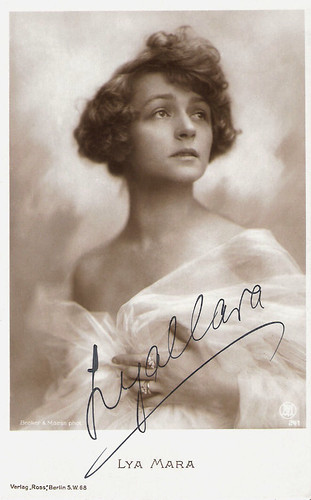
German postcard by Ross Verlag, no. 241, 1919-1924. Photo: Becker & Maass.

German postcard by Ross Verlag, no. 1455/3, 1927-1928. Photo: Atelier Balázs, Berlin.
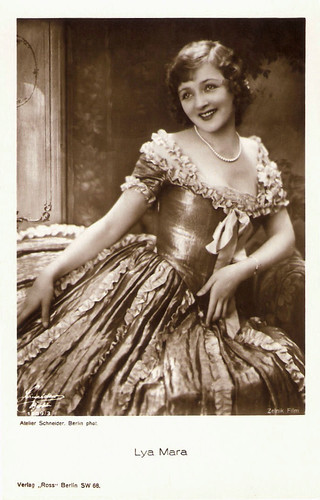
German postcard by Ross Verlag, no. 1889/3, 1927-1928. Photo: Atelier Schneider, Berlin / Zelnik-Film.
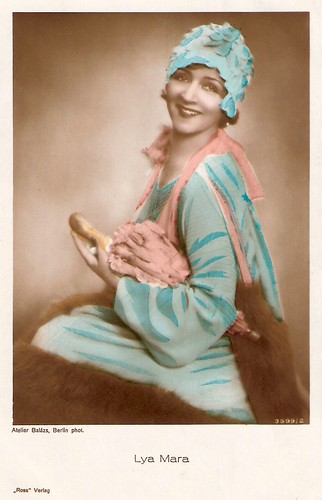
German postcard by Ross Verlag, no. 3599/1, 1928-1929. Photo: Atelier Balázs, Berlin.
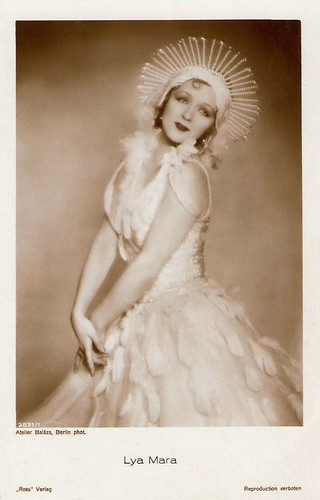
German postcard by Ross Verlag, no. 3831/1, 1928-1929. Photo: Atelier Balázs, Berlin.
Prima Ballerina
Lya Mara was born as Aleksandra Gudowiczóna in a Polish family in Riga, Russian Empire (now Latvia) in 1893 or 1897. She was the daughter of a civil servant and went to a Catholic boarding school.
As a young girl, she wanted to become a chemist, like Marie Curie, the then famous French woman scientist who was also Polish-born, but instead, Lya went to the ballet school of Riga. One year later, she was already a solo dancer and in the following years, she danced for the Riga State theatre and became astonishingly famous. This success was crowned with her promotion to prima ballerina in 1913.
Just before World War I, Lya moved with her family to Warsaw. Credited as Mia Mara, she played her first small part in the short silent comedy Wsciekly rywal/The Rival (Aleksander Hertz, 1916), and soon thereafter she played another part in Bestia/The Polish Dancer (Aleksander Hertz, 1917). Star of this film was another Polish actress, Pola Negri, who would make an extraordinary career in Germany and Hollywood. Negri left for Berlin, and soon Lya Mara would follow her steps.
Newspaper articles and pictures of Mara had appeared in Berlin newspapers, and she was spotted by the young and energetic actor-director-producer Friedrich Zelnik (later credited as Frederic Zelnik). He summoned her to Berlin. After some screen tests, she signed a contract that obligated her for a total of seven pictures with Zelnik.
Among their first films were Das Geschlecht der Schelme/The sex of the Scoundrel (Alfred Halm, 1917) opposite Zelnik himself, Halkas Gelöbnis/Halka's Vow (Alfred Halm, 1918) opposite Hans Albers, Die Rose von Dschiandur/The Rose of Dschiandur (Alfred Halm, 1918) again opposite Zelnik, and Die Serenyi (Alfred Halm, 1918) opposite Conrad Veidt.
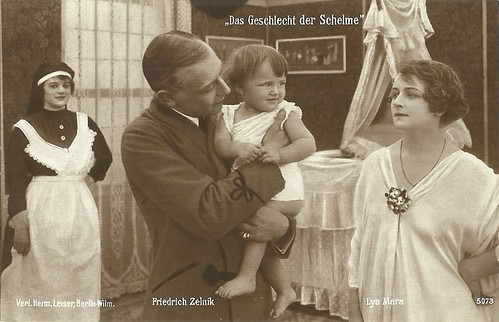
German postcard by Verl. Hermann Leiser, Berlin, no. 5073. Photo: Berliner Film-Manufaktur. Lya Mara and Friedrich Zelnik in Das Geschlecht der Schelme/The sex of the scroundel (H. Fredall a.k.a. Alfred Halm, 1917). Alfred Halm directed this film and the following films under his regular pseudonym H. Fredall, while he also scripted the film.
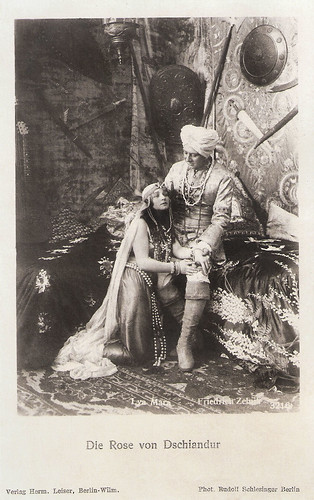
German postcard by Verlag Hermann Leiser, Berlin-Wilm, no. 3216. Photo: Rudolph Schlesinger. Photo: Berliner Film-Manufaktur. Friedrich Zelnik and Lya Mara in Die Rose von Dschiandur/The Rose of Dschiandur (Alfred Halm, 1918).

German postcard by Photochemie, Berlin, no. K. 2268. Photo: Berliner Film-Manufaktur. Lya Mara and Victor Janson in Die Serenyi (Alfred Halm, 1918). This is one of two cards Photchemie issued on this film.
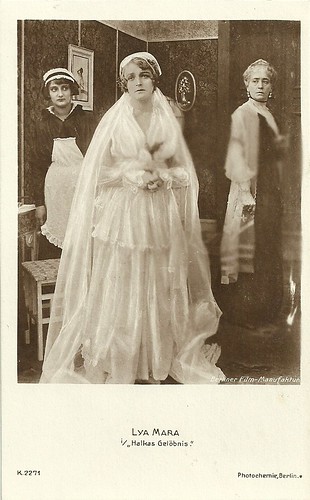
German postcard by Photochemie, Berlin, no. K. 2271/2. Photo: Berliner Film-Manufaktur. Lya Mara in Halkas Gelöbnis/Halka's Vow (Alfred Halm, 1918).

German postcard by Photochemie, Berlin, no. K. 2273. Photo: Berliner Film-Manufaktur. Lya Mara in Halkas Gelöbnis/Halka's Vow (H. Fredall a.k.a. Alfred Halm, 1918). This is one of a set of three cards that Photochemie issued on the film.
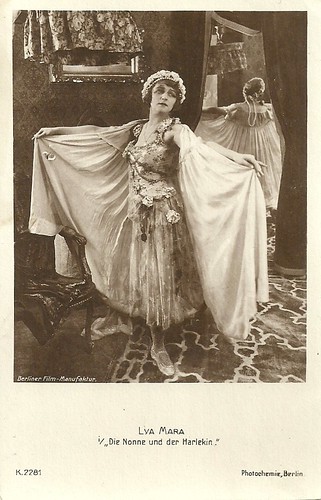
German postcard by Photochemie, Berlin, no. K. 2281. Photo: Berliner Film-Manufaktur. Lya Mara in Die Nonne und der Harlekin/The Nun and the Harlequin (Alfred Halm, 1918). This one of three cards Photochemie issued on the film.
Immensely Successful Operettas
Friedrich Zelnik and Lya Mara married in 1918. Zelnik promoted her to a major star in Germany. Among the following films, he directed and produced with her were Manon (1919), Charlotte Corday (1919), and Anna Karenina (1919) with Johannes Riemann.
From 1920 on, Zelnik's film production company was named Zelnik-Mara-Film GmbH. Lya starred in lightweight fare like Die Ehe der Fürstin Demidoff/The Marriage of Princess Demidoff (1921), and Das Mädel vom Picadilly/The Girl from Picadilly (1921), in which she either played noble ladies or naïve girls from the countryside.
From 1924 on, she only made two Zelnik films a year, among them immensely successful operettas like Die Försterchristel/The Bohemian Dancer (1926), An der schönen blauen Donau/The Beautiful Blue Danube (1926), and Das tanzende Wien/Dancing Vienna (1927), often with Harry Liedtke or Alfred Abel as her screen partner.
Lya Mara perfectly embodied the Viennese Girl, and she enjoyed great popularity all over Europe. Her stardom also was the subject of a novel, 'Lya. Der Herzensroman einer Kinokönigin' (Lya, The Heart Novel of a Cinema Queen), which was published in 100 episodes between 1927 and 1928.
Lya Mara and her husband became real celebrities and received at their home many known artists. Her popularity was further cemented by hundreds of her photographs issued as postcards, chocolate and cigarettes trade cards.

German postcard by Ross Verlag, no. 914/4, 1925-1926. Photo: Phoebus Film / Zelnik-Mara Film. Lya Mara in Auf Befehl der Pompadour/By Order of Pompadour (Friedrich Zelnik, 1924).

German postcard by Ross Verlag, no. 56/3, 1925-1926. Photo: Zelnik Film. Publicity still for An der schönen blauen Donau/The Beautiful Blue Danube (Friedrich Zelnik, 1926).
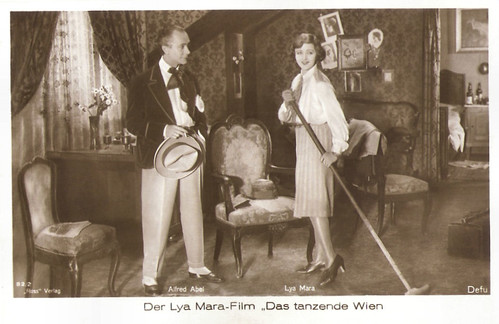
German postcard by Ross Verlag, no. 82/2. Photo: Defu. Alfred Abel and Lya Mara in Das tanzende Wien/Dancing Vienna (Friedrich Zelnik, 1927).
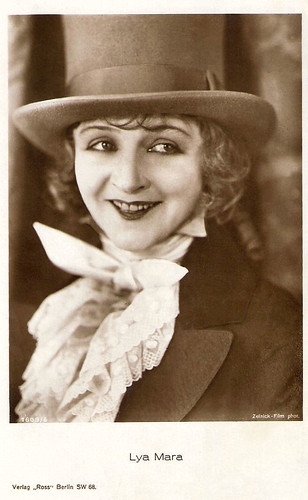
German postcard by Ross Verlag, no. 1608/6, 1927-1928. Photo: Zelnick-Film. Lya Mara in Die lachende Grille/The Merry Madcap (Friedrich Zelnik, 1926)

German postcard by Ross Verlag, no. 3413/3, 1928-1929. Photo: Defina / DEFU.

German postcard by Ross Verlag, no. 3414/1, 1928-1929. Photo: Defina / DEFU. Fred Louis Lerch and Lya Mara in Heut tanzt Mariett/Today dances Mariett (Friedrich Zelnik, 1928). Collection: Geoffrey Donaldson Institute.
Lost Traces
A serious car accident at the end of the 1920s interrupted Lya Mara's career. There was an immensely huge sympathy from the audience, but somehow she could not adapt her acting to the sound cinema, introduced in Germany in 1929.
While Friedrich Zelnik became the first director in Germany who post-synchronised foreign films, Lya Mara's only film from the sound era is Jeder fragt nach Erika/Everyone Asks for Erika (Friedrich Zelnik, 1931).
In 1932, just before Adolf Hitler took over the power in Germany, Lya Mara and Friedrich Zelnik went into exile in London. There is no record of her acting there, although her husband continued to direct and produce films in England and The Netherlands until 1939.
Friedrich Zelnik died in London in 1950, and since then all traces of his wife were lost for a long time. Lya Mara probably spent her last years with her sister in Switzerland and most sources indicate that she died there in 1960 at the age of 62.
However, 'Ms. Sherlock'Marlene Pilaete discovered the correct facts: "Some passionate historians have found mention of her death in local newspapers. How lucky we are to have such people making research. For example, the Nouvelle Revue de Lausanne mentions on the 6th of November 1969 in its obituary page "Alexandra Zelnik-Gudowicz, 76 years old". At the time, nobody knew that she had been a famous movie star. Please note that, if she was 76 years old when she passed away, it seems that she was born in 1893 and not 1897. Maybe another case of 'rejuvenation'… It wouldn’t be the first time… especially regarding actresses."
So, Lya Mara settled down in Lausanne, Switzerland in 1966. She passed away in that city on 1 November 1969 and she was buried in the cemetery of Bois-de-Vaux. Her grave has been disaffected in 2007.
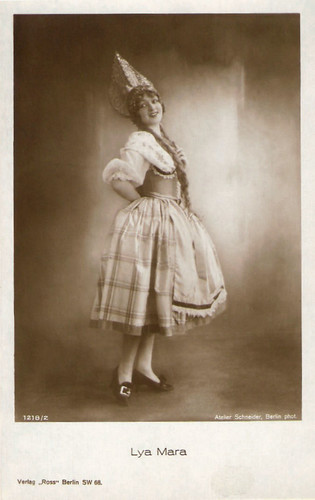
German postcard by Ross Verlag, no. 1218/2, 1927-1928. Photo: Atelier Schneider, Berlin.

German postcard by Ross Verlag, no. 1368/2, 1927-1928. Photo: Atelier Balázs, Berlin.

German postcard by Ross Verlag, no. 1401/2, 1927-1928. Photo: Atelier Schneider, Berlin.

German postcard by Ross Verlag, no. 1455/4, 1927-1928. Photo: Atelier Balázs, Berlin.
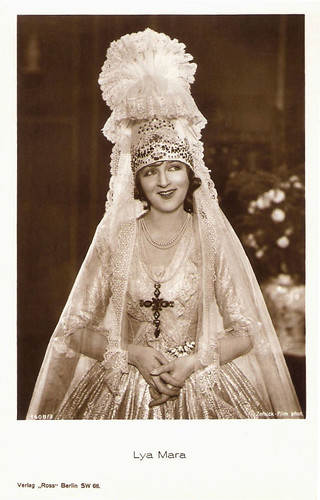
German postcard by Ross Verlag, no. 1608/3, 1927-1928. Photo: F. Zelnick-Film.

German postcard by Ross Verlag, no. 1740/7, 1927-1928. Photo: Atelier Balázs, Berlin / Zelnick Film.

German postcard by Ross Verlag, no. 3449/1, 1928-1929. Photo: G.L. Manuel Frères, Paris.

German postcard by Ross Verlag, no. 3953/5, 1928-1929. Photo: Atelier Balázs, Berlin.
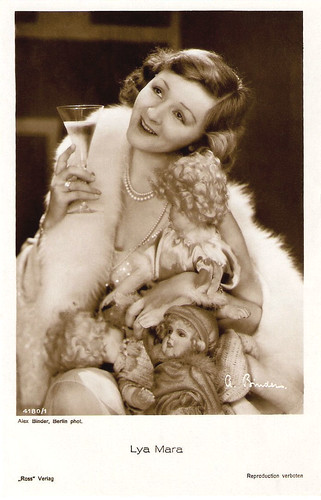
German postcard by Ross Verlag, no. 4180/1, 1929-1930. Photo: Alex Binder, Berlin.

German postcard by Ross Verlag, no. 4308/4, 1929-1930. Photo: Ernst Schneider, Berlin.
Sources: Marlene Pilaete (La Collectionneuse - French), Thomas Staedeli (Cyranos), Filmportal.de, Wikipedia, and IMDb.




































